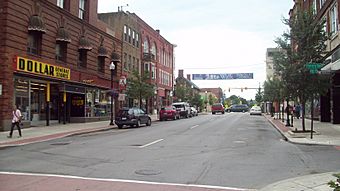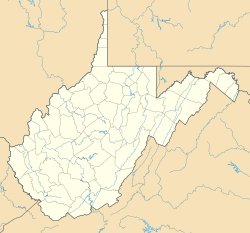Downtown Morgantown Historic District facts for kids
Quick facts for kids |
|
|
Downtown Morgantown Historic District
|
|

Downtown Morgantown, September 2012
|
|
| Location | Roughly bounded by Chestnut and Spruce Sts. between Foundry and Willey Sts., Morgantown, West Virginia |
|---|---|
| Area | 75 acres (30 ha) |
| Architect | Jacobs, Elmer; et al. |
| Architectural style | Italianate, Greek Revival, Federal |
| NRHP reference No. | 96000441 |
| Added to NRHP | May 2, 1996 |
The Downtown Morgantown Historic District is a special area in Morgantown, West Virginia, that has been recognized for its important history. It's like a big outdoor museum! This district covers about 75 acres and includes 122 buildings and 2 sites that tell a story about the past. These include old shops, public buildings, homes, and churches.
This historic area was added to the National Register of Historic Places on May 2, 1996. That means it's officially protected and valued for its history. Ten of the buildings in this district are so important that they are listed separately on the National Register. Some famous spots here are the Monongalia County Courthouse, the Metropolitan Theater, and the Old Morgantown Post Office (which is now the Monongalia Arts Center).
Contents
History of Morgantown's Downtown
This historic district shows us how Morgantown and the area around it grew between 1795 and 1945. It tells us about old buildings, how people lived, and the industries that were important back then.
Morgantown is located right by the Monongahela River. This river flows north all the way to Pittsburgh, and then connects to the Ohio and Mississippi Rivers. Being so close to the river made Morgantown a key spot for people moving west across the country.
In the late 1750s, settlers started building small farms in this area. Zackquill Morgan, who founded the town, got a special land grant in 1784. This land was 50 acres big, right where Deckers Creek meets the river. Morgan had already started a small settlement there in 1772. After fighting as a colonel in the Revolutionary War, he came back. He planned out the town on his property and got a special paper called a "charter" for "Morgan’s Town" in 1785.
The town grew slowly in the early 1800s. Its growth mainly came from sending farm products and goods made in factories north along the river. During the Civil War, Morgantown strongly supported the Union (the northern states). Waitman T. Willey, a local lawyer, lived in town. He was a leader in the effort to create the state of West Virginia. Confederate raiders briefly took over the town during the war. They wanted to capture Willey, but he had already left.
After the war, Morgantown grew much faster. Transportation got better, and industries like oil, coal, and timber expanded. Many new immigrants came to work in these growing businesses. During this time, Morgantown also became a center for education. West Virginia University was created, building on earlier schools. As more people came for education and industry, many new offices, homes, churches, and other buildings were constructed. The historic district shows all this growth from the past two and a half centuries.
Where is the Historic District?
The boundaries of the historic district follow the original town plan. This plan was laid out by Zackquill Morgan in 1785.
The main street in the middle of the district is High Street. It runs between Chestnut Street and Spruce Street. To the north, the district ends at Willey Street. This street separates downtown from the West Virginia University campus. To the south, Foundry Street marks the boundary, running along Decker's Creek.
To the west, Chestnut Street forms the edge, running next to the Monongahela River. To the east, Spruce Street is the boundary. It also runs along Decker's Creek, with bridges crossing over to the nearby South Park Historic District.
Building Styles in Downtown Morgantown
The buildings in the historic district show different architectural styles. These styles were popular in the region between 1795 and 1945. The oldest buildings in the district are in the Federal style. This style was common in the years after the Revolutionary War.
Buildings from the late 1800s and early 1900s show many different styles. These include Classic Revival, Victorian, Gothic Revival, Italianate, and Romanesque. Many buildings in the district were designed by Elmer Jacobs. He was a local architect. Jacobs used many popular styles from the Gilded Age. This created a mix of interesting buildings in the downtown area.
Important Buildings in the District
Many buildings in the Downtown Morgantown Historic District are special. Here are some of the most notable ones:
Buildings Listed Separately on the National Register
- Brown Building (also called the Ream Building): Built in 1898, this four-story brick building was designed by Elmer Jacobs. It has a flat roof and a decorative edge at the top.
- Dering Building: Built in 1896, this commercial building was also designed by Elmer Jacobs. It's a three-story stone building in the Romanesque Revival style. It has a triangular top part (called a pediment) above the roof with a rising sun design and the building's date.
- Judge Frank Cox House: Built around 1898, this two-and-a-half-story brick house is in the Queen Anne style. Elmer Jacobs designed it. It features a three-story tower, five chimneys with fancy brickwork, stained glass windows, and a wooden porch. This was the home of Judge Frank Cox, a local lawyer who served on West Virginia's highest court.
- Metropolitan Theatre: This theater opened on July 24, 1924. Its brick front has tall, fluted concrete columns (called Ionic order pilasters) with decorative details. It's in the Classical Revival style. The theater still hosts live shows today. It has a main floor, a balcony, two shops on the ground floor, and a pool hall in the basement.
- Monongalia County Courthouse: Built in 1891, this two-story building is in the Romanesque style. It has a five-story clock tower and another three-story round tower. An Italianate style jailhouse, built in 1881, is connected to it.
- Old Morgantown Post Office: Built in 1913, this building was originally a post office owned by the government. It was designed by Oscar Wenderoth in the Classical Revival style. When the post office moved in the 1970s, a family bought the building. They started the Monongalia County Arts Association, Inc., which is now the Monongalia Arts Center.
- Old Stone House: Built around 1796, this is a two-story stone house. A one-story wooden addition was built in the early 1900s. It was the home of John W. Thompson, who was a potter. It's one of the oldest examples of pioneer homes in Monongalia County.
- Rogers House: Built around 1857, this two-story house is made of brick and wood. It's in the Classical Revival style. The original part is brick. An addition, designed by Elmer Jacobs, was built in 1905-1906. This was the home of the Rogers family, who were early settlers of Morgantown.
- Women's Christian Temperance Union Community Building: Built in 1922, this four-story brick building is in the Classical Revival style. It has a smooth stone ledge (a cornice) topped with a decorative railing (a balustrade). The building also has offices, meeting rooms, apartments, and places for fun activities.
- Walters House (also known as the Stone, Gallagher and Byrne Law Offices): Built around 1900, this house is in the Queen Anne style. It's a brick house with a three-story tower in one corner. This tower has a fancy iron railing at the top.
Other Important Buildings
The historic district also has many other important buildings. These include different shops, public buildings, homes, and churches. Some notable commercial buildings are the law offices on Chancery Row (from about 1855). This includes the old office of Waitman T. Willey, who was one of West Virginia's first senators.
Other commercial buildings include the Knights of Columbus Building, which is important to the town's labor history. There's also the Curtis Electrical and State Electronics building, which used to be the Davis Brothers garage and had an early patented driving ramp. The Monongahela Building once housed the offices of many coal company leaders.
Important homes in the district include the Neville House (1823), the Crow-Garlow-Lewin House, and the John Rogers House (now the Dering Funeral Home, built in the 1840s in the Federal style). Churches in the district include the Spruce Street United Methodist Church (built in 1908 and designed by Elmer Jacobs) and Wesley United Methodist Church (built in 1942). The historic district is also home to Morgantown City Hall (1924) and the historic Warner Theater (1931).
- Callahan, James Morton. History of the Making of Morgantown, West Virginia: A Type Study in Trans-Appalachian Local History. Morgantown, WV: Morgantown Printing and Binding Co., 1926.
- Callahan, James Morton. History of West Virginia: Old and New. Chicago and New York: The American Historical Society, 1923.
- Chambers, S. Allen. Buildings of West Virginia. Oxford and New York: Oxford University Press, 2004.
- Core, Earl L. and Mildred S. Clark, eds. Bicentennial of Monongalia County West Virginia 1976. Parsons, WV: McClain Printing Company, 1980.
- Core, Earl. The Monongalia Story: A Bicentennial History, Volumes I-V. Parsons, WV: McClain Printing Co., 1974-1984.
- Rice, Connie Park. Our Story: A History of African Americans in Monongalia County, West Virginia. Terra Alta, WV: Headline Books, Inc., 1999.
- West Virginia University Public History Option. Morgantown: A Bicentennial History. Terra Alta, WV: Pioneer Press of West Virginia, Inc., 1985.
- Wiley, Samuel T. History of Monongalia County, West Virginia, from its First Settlements to the Present Time; With Numerous Biographical and Family Sketches. Kingwood, WV: Preston Pub. Co., 1883.
- City of Morgantown [1]
- Main Street Morgantown [2]
- Metropolitan Theater [3]
- Morgantown History Museum [4]
- Monongalia County Commission [5]
- Monongalia Arts Center [6]



